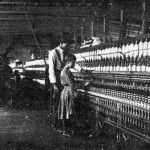Child Labour in the 19th Century
Category: 19th century The shameful practice of child labour played an important role in the Industrial Revolution from its outset. The displaced working classes, from the seventeenth century on, took it for granted that a family would not be able to support itself if the children were not employed. The children of the poor were forced by economic conditions to work, as Charles Dickens, with his family in debtor’s prison, worked at the age of twelve in the blacking factory.
The shameful practice of child labour played an important role in the Industrial Revolution from its outset. The displaced working classes, from the seventeenth century on, took it for granted that a family would not be able to support itself if the children were not employed. The children of the poor were forced by economic conditions to work, as Charles Dickens, with his family in debtor’s prison, worked at the age of twelve in the blacking factory.
In 1840 perhaps only twenty percent of the children of London had any schooling, a number which had risen by 1860, when perhaps half of the children between 5 and 15 were in some sort of school, if only a day school (of the sort in which Dickens’s Pip finds himself in “Great Expectations”) or a Sunday school; the others were working. Many of the more fortunate found employment as apprentices to respectable trades or as general servants — there were over 120,000 domestic servants in London alone at mid-century, who worked 80 hour weeks for one halfpenny per hour — but many more were not so lucky. Most prostitutes (and there were thousands in London alone) were between 15 and 22 years of age.
Many children worked 16-hour days under atrocious conditions, as their elders did. The first parliamentary acts to regulate the work of workhouse children in factories and cotton mills to 12 hours per day had been passed as early as 1802 and 1819. These acts turned to be ineffective, and after radical agitation, notably in 1831, when “Short Time Committees” organized largely by Evangelicals began to demand a ten-hour day, a royal commission established by the Whig government recommended in 1833 that children aged 11-18 should work a maximum of twelve hours a day; children aged 9-11 were allowed to work eight-hour days; and children under 9 were no longer permitted to work at all, though previously children as young as 3 had been put to work.
The Act of 1833 applied only to the textile industry, where children were put to work at the age of five. Iron and coal mines (where children, again, both boys and girls, began to work at the age five, and generally died before they were twwenty-five), gas works, shipyards, construction, match factories, nail factories, and the business of chimney sweeping, for example, went on to exploit child labour extensively. In 1847, after further radical agitation, another parliamentary act limited both adults and children to ten hours of work daily.
